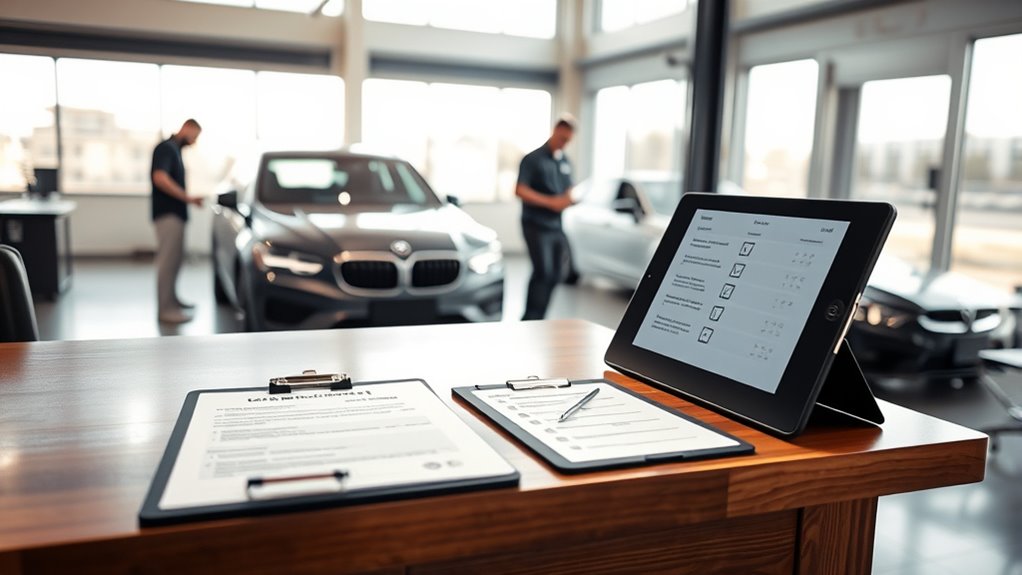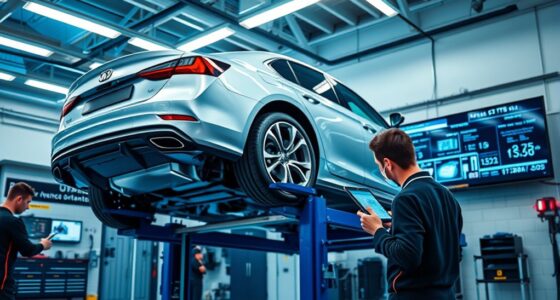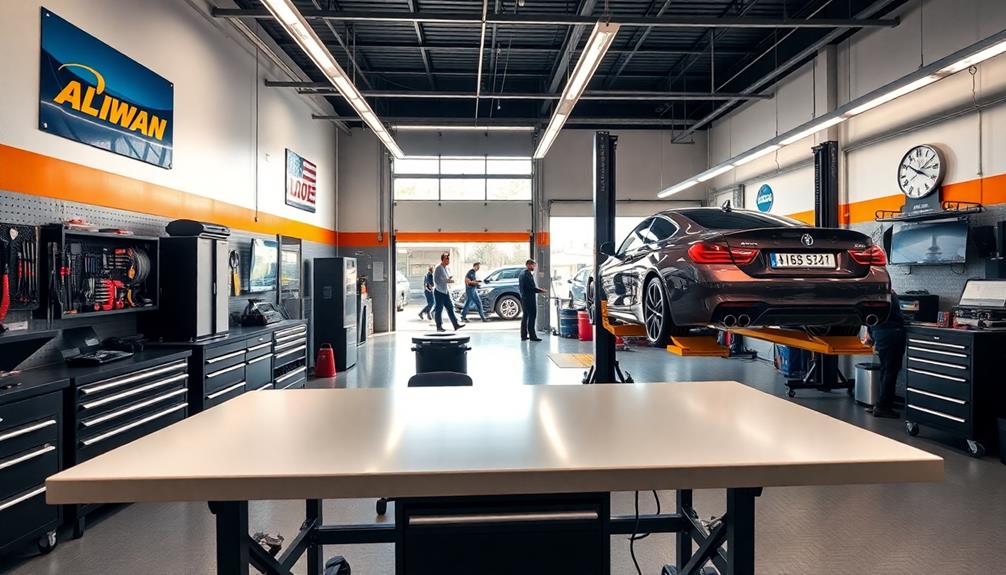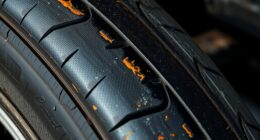A vehicle reception checklist helps you thoroughly inspect a vehicle upon arrival. You’ll examine the exterior for damage, check all lights, and inspect the interior for wear and functionality. Don’t forget to verify tire pressure, tread, and brake system, along with fluid levels for oil, coolant, and brake fluid. Proper documentation is vital, so record everything carefully, including registration, insurance, and repairs. Keep these steps in mind, and you’ll guarantee a smooth evaluation process—more details ahead to guide you.
Key Takeaways
- Conduct a comprehensive exterior and interior vehicle inspection for damages, wear, and operational controls.
- Verify tire pressure, tread, and brake system functionality for safety and performance.
- Check fluid levels including oil, coolant, brake, and washer fluids to identify maintenance needs.
- Document all findings, damages, repairs, and vehicle history for transparency and record-keeping.
- Ensure legal documentation such as registration, insurance, and warranties are current and correctly matched.

When you receive a new vehicle, performing a thorough reception checklist guarantees you catch any issues early and establish a clear record of its condition. This initial step is crucial for maintaining high standards and providing transparency for your customers. Start with a comprehensive vehicle inspection, carefully examining both the exterior and interior. Check the body for dents, scratches, rust, and paint inconsistencies. Make sure all lights—headlights, brake lights, turn signals—are functioning properly. Look for any signs of previous damage or repairs that might indicate underlying problems. Inside, inspect the seats, dashboard, and controls for wear and tear, ensuring everything is clean and operational.
Perform a thorough vehicle inspection to identify issues early and document its condition clearly.
As you conduct your vehicle inspection, pay close attention to tires and wheels. Check tire pressure and tread depth, and look for any punctures or uneven wear that could signal alignment issues. Inspect the brake system visually, and if necessary, perform a test to confirm responsiveness. Don’t forget to verify fluid levels—oil, coolant, brake fluid, and windshield washer—to ensure they’re within recommended ranges. This helps identify potential maintenance needs early and avoids surprises down the line. Additionally, understanding the importance of projector technology can enhance your ability to evaluate multimedia systems during vehicle inspections, especially for tech-equipped vehicles.
Customer documentation plays a vital role in this process as well. Record all findings meticulously, including any imperfections or mechanical concerns. Providing thorough documentation not only safeguards your business but also builds trust with your customer. When you hand over the vehicle, accompany it with a detailed report highlighting the current condition and any recommended repairs or maintenance. This documentation becomes part of the vehicle’s history and can be referenced in future inspections or sales.
It’s also wise to verify the vehicle’s registration, insurance, and service records during reception. Confirm that all paperwork is up-to-date and matches the vehicle’s VIN. This step ensures legal compliance and prevents future disputes. If the vehicle is being traded in or sold, take note of any warranties or outstanding recalls, and inform the customer accordingly. Accurate customer documentation simplifies the process of addressing issues later and enhances your professional credibility.
Frequently Asked Questions
How Often Should Vehicle Reception Checklists Be Updated?
You should update vehicle reception checklists regularly, ideally aligning with your maintenance schedule or after significant vehicle updates. Keep staff training in mind—ensure your team understands any changes to the checklist. Regular updates help catch new issues early and maintain safety standards. Review the checklist at least every six months or whenever new vehicle features are added, so your team stays informed and prepared for proper vehicle reception and maintenance.
Can Digital Checklists Replace Paper Forms Effectively?
Digital checklists can effectively replace paper forms by offering seamless digital integration and real-time updates. You benefit from a more efficient, paperless solution that reduces errors and speeds up vehicle reception. With digital tools, you can easily track and store records securely, improving accuracy and compliance. Embracing these paperless solutions not only streamlines your process but also helps your team stay organized and environmentally conscious.
Who Is Responsible for Conducting the Vehicle Reception Inspection?
You are responsible for conducting the vehicle reception inspection. Follow the established inspection protocols to ensure a thorough assessment. Make certain responsible personnel, such as your supervisor or designated team members, oversee the process to maintain accountability. By adhering to these protocols, you help identify any damages or issues early, guaranteeing the vehicle meets safety and quality standards before proceeding. Your attention to detail is vital in this process.
What Are Common Mistakes to Avoid During Vehicle Checks?
Did you know that 30% of vehicle issues are caused by overlooked checks? During vehicle checks, avoid rushing and neglecting details. Focus on driver training to ensure thorough inspections, and customize your checklist to suit specific vehicle types. This reduces errors and improves safety. Stay attentive, verify all components carefully, and don’t skip steps—these practices help prevent costly repairs and ensure smooth operations.
How Should Discrepancies Found During Inspection Be Documented?
When you find discrepancies during inspection, you should promptly document them through clear and detailed inspection documentation. Use discrepancy reporting to record the issues accurately, noting their nature, location, and severity. Make sure to include date, time, and your signature for accountability. Proper documentation guarantees issues are addressed efficiently and provides a record for future reference, preventing misunderstandings and maintaining vehicle safety and compliance.
Conclusion
By following this vehicle reception checklist, you guarantee a smooth and thorough inspection every time. Did you know that 85% of vehicle issues are detected during initial inspections? Catching problems early can save you time and money down the line. So, stay diligent, use the checklist consistently, and keep your vehicle in top shape. Remember, a little extra effort now can prevent bigger headaches later—your vehicle will thank you!









